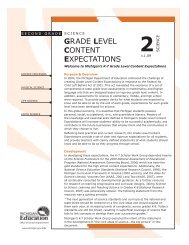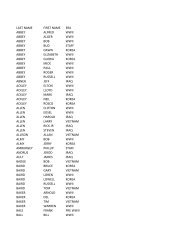Grade Level Content Expectations - State of Michigan
Grade Level Content Expectations - State of Michigan
Grade Level Content Expectations - State of Michigan
You also want an ePaper? Increase the reach of your titles
YUMPU automatically turns print PDFs into web optimized ePapers that Google loves.
Curriculum<br />
Using this document as a focal point in the school improvement process, schools and districts can<br />
generate conversations among stakeholders concerning current policies and practices to consider<br />
ways to improve and enhance student achievement. Together, stakeholders can use these<br />
expectations to guide curricular and instructional decisions, identify pr<strong>of</strong>essional development<br />
needs, and assess student achievement.<br />
Understanding the Organizational Structure<br />
The expectations in this document are divided into strands with multiple domains within each, as<br />
shown below. The skills and content addressed in these expectations will in practice be woven<br />
together into a coherent, Mathematics curriculum. The domains in each mathematics strand are<br />
broader, more conceptual groupings. In several <strong>of</strong> the strands, the “domains” are similar to the<br />
“standards” in Principles and Standards for School Mathematics from the National Council <strong>of</strong><br />
Teachers <strong>of</strong> Mathematics.<br />
To allow for ease in referencing expectations, each expectation has been coded with a strand,<br />
domain, grade-level, and expectation number. For example, M.UN.00.01 indicates:<br />
M- Measurement strand<br />
UN - Units & systems <strong>of</strong> measurement domain <strong>of</strong> the Measurement strand<br />
00 - Kindergarten Expectation<br />
01- First Expectation in the <strong>Grade</strong>-<strong>Level</strong> view <strong>of</strong> the Measurement strand<br />
Strand 1<br />
Number &<br />
Operations<br />
Strand 2 Algebra<br />
Strand 3<br />
Measurement<br />
Strand 4<br />
Geometry<br />
Strand 5<br />
Data and<br />
Probability<br />
Domains<br />
Meaning, notation,<br />
place value, and<br />
comparisons (ME)<br />
Number<br />
relationships<br />
and meaning <strong>of</strong><br />
operations (MR)<br />
Fluency with<br />
operations and<br />
estimation (FL)<br />
Patterns, relations,<br />
functions, and<br />
change (PA)<br />
Representation (RP)<br />
Formulas,<br />
expressions,<br />
equations, and<br />
inequalities (RP)<br />
Units and systems <strong>of</strong><br />
measurement (UN)<br />
Techniques and<br />
formulas for<br />
measurement (TE)<br />
Problem<br />
solving involving<br />
measurement (PS)<br />
Geometric shape,<br />
properties, and<br />
mathematical<br />
arguments (GS)<br />
Location and spatial<br />
relationships (LO)<br />
Spatial reasoning<br />
and geometric<br />
modeling (SR)<br />
Transformation and<br />
symmetry (TR)<br />
Data representation<br />
(RE)<br />
Data interpretation<br />
and analysis (AN)<br />
Probability (PR)<br />
Preparing Students for Academic Success<br />
Within the hands <strong>of</strong> teachers, the <strong>Grade</strong> <strong>Level</strong> <strong>Content</strong> <strong>Expectations</strong> are converted into exciting<br />
and engaging learning for <strong>Michigan</strong>’s students. As we use these expectations to develop units <strong>of</strong><br />
instruction and plan instructional delivery, it is critical to keep in mind that content knowledge<br />
alone is not sufficient for academic success. Students must be able to apply knowledge in new<br />
situations, to solve problems by generating new ideas, and to make connections between what<br />
they learn in class to the world around them. The art <strong>of</strong> teaching is what makes the content <strong>of</strong><br />
learning become a reality.<br />
Through the collaborative efforts <strong>of</strong> <strong>Michigan</strong> educators and creation <strong>of</strong> pr<strong>of</strong>essional learning<br />
communities, we can enable our young people to attain the highest standards, and thereby open<br />
doors for them to have fulfilling and successful lives.<br />
2 S I X T H G R A D E M A T H E M A T I C S ■ v. 1 2 . 0 5 ■ M I C H I G A N D E P A R T M E N T O F E D U C A T I O N






